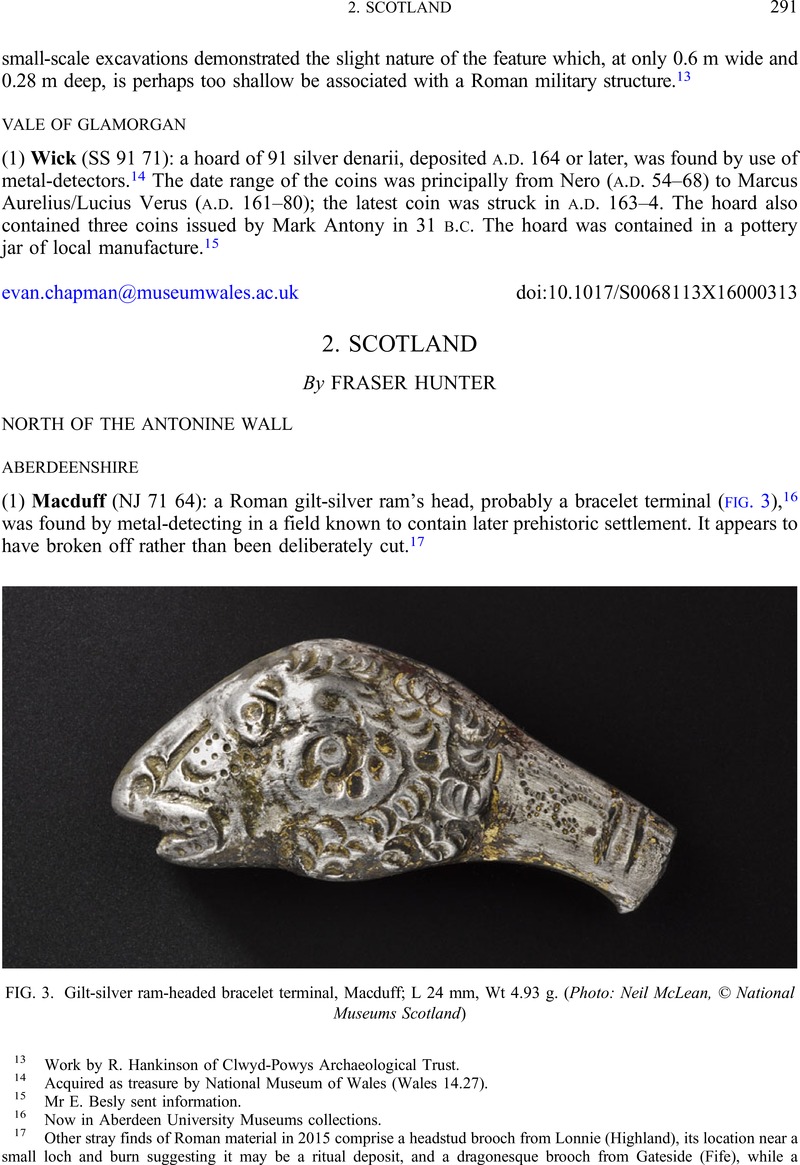No CrossRef data available.
Article contents
2. SCOTLAND
Published online by Cambridge University Press: 13 September 2016
Abstract

Information
- Type
- Roman Britain in 2015
- Information
- Copyright
- Copyright © The Author(s) 2016. Published by The Society for the Promotion of Roman Studies
References
16 Now in Aberdeen University Museums collections.
17 Other stray finds of Roman material in 2015 comprise a headstud brooch from Lonnie (Highland), its location near a small loch and burn suggesting it may be a ritual deposit, and a dragonesque brooch from Gateside (Fife), while a bell-shaped stud was found beside Roman Dere Street at Soutra (Midlothian); see Discovery and Excavation in Scotland 16 (2015), 84–5, 112–13Google Scholar, 122. A brooch ‘from Montrose’ (ibid., 35) is the example from Dunnichen reported previously ( Britannia 44 (2013), 283 n. 32Google Scholar).
18 Reported by Joe Gierasik and discussed with Dr D.J. Woolliscroft. For the site see Jones, R.H., Roman Camps in Scotland (2011), 236–7Google Scholar. The presence of a further camp in the area is implied by the 1980s excavations at Dundee High Technology Park which revealed features now recognisable as Roman field ovens some 700 m to the north; see G ibson, and Tavener, , PSAS 119 (1989), 83–9Google Scholar.
19 For E. Crookston by D. Hall, who sent a report.
20 Jones, R.H., Roman Camps in Scotland (2011), 254–5Google Scholar. Earlier excavations, likewise barren, are reported in Britannia 42 (2011), 330Google Scholar with further references.
21 For Mr and Mrs Burrows by D. Hall, who sent a report.
22 Led by Dr T. Poller as part of Glasgow University's SERF Project.
23 For which see Jones, R.H., Roman Camps in Scotland (2011), 205–6Google Scholar.
24 By Dr F. Hunter of National Museums Scotland; the finds are in Falkirk Museum.
25 Identified by Dr S. Moorhead; now in Clydebank Museum. Full publication is planned.
26 For Anderson Bell & Christie by A. Hunter Blair and K. Green of GUARD Archaeology; B. Will sent a report.
27 Led by M. Kilpatrick of GUARD Archaeology for Caledonian Properties Ltd; B. Will sent a report.
28 For the fort, see S.N. Miller, The Roman Fort at Balmuildy (1922).
29 For Freedom Network Services by J. Lochrie of Headland Archaeology, who sent a report.
30 See Jones, R.H., Roman Camps in Scotland (2011), 313Google Scholar.
31 By P. Fox of Kirkdale Archaeology for Historic Scotland.
32 By G. Bailey, who sent a report.
33 See Britannia 39 (2008), 275Google Scholar for earlier work in the vicinity.
34 Led by G. Bailey (who sent a report) for Falkirk Community Trust and Edinburgh Archaeological Field Society; for earlier work see Britannia 46 (2015), 289Google Scholar.
35 For Falkirk Community Trust by G. Bailey, who sent a report.
36 Now in Falkirk Museum; full publication by F. Hunter in PSAS 145 (forthcoming).
37 Led by G. Bailey (who supplied information) for Falkirk Community Trust and Edinburgh Archaeological Field Society.
38 By the Survey and Recording team at Historic Environment Scotland; A. Welfare sent details. For the site, see JRS 43 (1953), 105–7Google Scholar; Robertson, A., PSAS 97 (1963–4), 198–200 Google Scholar.
39 For Fouin and Bell Architects by N. Johnstone of AOC Archaeology; M. Cook sent a report.
40 The site lies north of the ridge which housed the bulk of the fort complex, but an extensive surrounding area saw some Roman activity; see M.C. Bishop, Roman Inveresk: Past, Present and Future (2002), map inside rear cover.
41 By the Survey and Recording team at Historic Environment Scotland; A. Welfare sent details. For the site, see RCAHMS, Eastern Dumfriesshire: an Archaeological Landscape (1997), 397, no. 1220 Google Scholar.
42 Led by Dr A. Posluschny, then of the Römisch-Germanische Kommission, as part of the Archaeolandscapes Europe project.
43 For discussion of the site, see Jobey, G., TDGNHAS 53 (1978), 67–104 Google Scholar; Campbell, D., Britannia 34 (2003), 19–33 CrossRefGoogle Scholar; Keppie, L. in Hanson, W.S. (ed.), The Army and Frontiers of Rome (2009), 241–52Google Scholar; Breeze, D., Archaeological Journal 168 (2011), 166–80CrossRefGoogle Scholar; Reid, J., Current Archaeology 316 (2016), 20–6Google Scholar.
44 The work, sponsored by the Heritage Lottery Fund, Dumfries and Galloway Natural History and Antiquarian Society and the Trimontium Trust, was led by Dr J. Reid and A. Nicholson; Dr Reid sent details.
45 Greep, S., Britannia 18 (1987), 183–200 CrossRefGoogle Scholar.
46 Led by Dr A. Posluschny for the Römisch-Germanische Kommission as part of the Archaeolandscapes Europe project.
47 Known from aerial photography; see RCAHMS, Eastern Dumfriesshire: an Archaeological Landscape (1997), 177, fig. 18; 309, no. 1208 Google Scholar.
48 For further details see Discovery and Excavation in Scotland 16 (2015), 59Google Scholar. The finds are in Dumfries Museum.
49 For further details see Discovery and Excavation in Scotland 16 (2015), 56Google Scholar; the handle will be published in F. Hunter, PSAS 145 (forthcoming). The finds are in Stewartry Museum.
50 By J. Pickin for CIET (UK) Ltd.
51 For the site see Jones, R.H., Roman Camps in Scotland (2011), 215–16Google Scholar.

